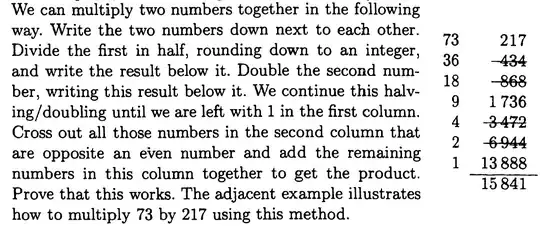I got this problem in the book Topics in the Theory of Numbers by Paul Erdos and Janos Suranyi and I found it very interesting. I have no idea how to prove this. (Although I believe it can be proved by a lot of methods.)
All I could conclude was the following:
- If $A$ and $B$ are two numbers, this method sums the quantity $[\frac{A}{2^i}]\cdot2^iB$ only when the greatest integer function has odd value. (There will be only a finite number of terms as $[\frac{A}{2^i}]$ will eventually become $0$ after some $i>i_0.$)
- I also tried writing $A$ and $B$ in the form as $A= \sum_{i=0}^{n} a_i\cdot10^i$ and $B= \sum_{j=0}^{m} b_j\cdot10^j$ but could not reach to any conclusion.
Any sort of help is appreciated.
Also, I would like to know how efficient is this method for calculating the product of two numbers in computer algebra systems (for example PARI/GP) compared to the other methods currently being used?

$$f(a,b,c), :=, \begin{cases}\qquad\qquad\qquad\quad! c,\ \ \ \ \ \ \ \ {\rm if}\ \ a=0\[.3em] f(\ \ \ \ a/2,\ \ \ \ \ 2b,\ c)\ \ \ \ \ \ \ {\rm if}\ \ a\ ,{\rm is\ even}\[.3em] f((a!-!1)/2,,2b,\ c!+!b)\ \ {\rm if}\ \ a\ ,{\rm is\ odd}\ \end{cases}\qquad$$
– Bill Dubuque Mar 03 '20 at 21:44